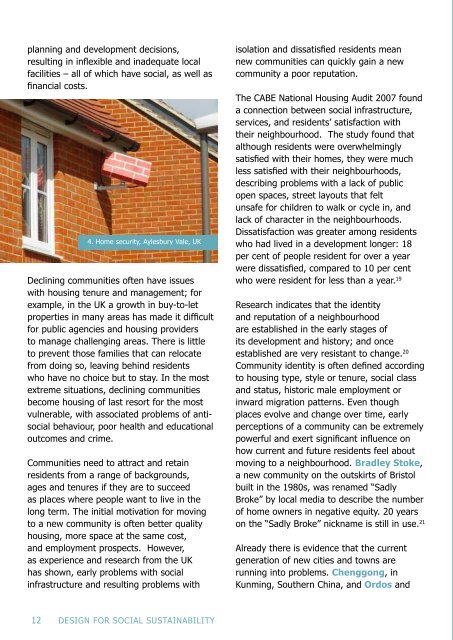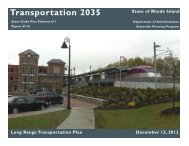Design for Social Sustainability â Saffron Woodcraft, 2010
Design for Social Sustainability â Saffron Woodcraft, 2010
Design for Social Sustainability â Saffron Woodcraft, 2010
Create successful ePaper yourself
Turn your PDF publications into a flip-book with our unique Google optimized e-Paper software.
planning and development decisions,<br />
resulting in inflexible and inadequate local<br />
facilities – all of which have social, as well as<br />
financial costs.<br />
4. Home security, Aylesbury Vale, UK<br />
Declining communities often have issues<br />
with housing tenure and management; <strong>for</strong><br />
example, in the UK a growth in buy-to-let<br />
properties in many areas has made it difficult<br />
<strong>for</strong> public agencies and housing providers<br />
to manage challenging areas. There is little<br />
to prevent those families that can relocate<br />
from doing so, leaving behind residents<br />
who have no choice but to stay. In the most<br />
extreme situations, declining communities<br />
become housing of last resort <strong>for</strong> the most<br />
vulnerable, with associated problems of antisocial<br />
behaviour, poor health and educational<br />
outcomes and crime.<br />
Communities need to attract and retain<br />
residents from a range of backgrounds,<br />
ages and tenures if they are to succeed<br />
as places where people want to live in the<br />
long term. The initial motivation <strong>for</strong> moving<br />
to a new community is often better quality<br />
housing, more space at the same cost,<br />
and employment prospects. However,<br />
as experience and research from the UK<br />
has shown, early problems with social<br />
infrastructure and resulting problems with<br />
isolation and dissatisfied residents mean<br />
new communities can quickly gain a new<br />
community a poor reputation.<br />
The CABE National Housing Audit 2007 found<br />
a connection between social infrastructure,<br />
services, and residents’ satisfaction with<br />
their neighbourhood. The study found that<br />
although residents were overwhelmingly<br />
satisfied with their homes, they were much<br />
less satisfied with their neighbourhoods,<br />
describing problems with a lack of public<br />
open spaces, street layouts that felt<br />
unsafe <strong>for</strong> children to walk or cycle in, and<br />
lack of character in the neighbourhoods.<br />
Dissatisfaction was greater among residents<br />
who had lived in a development longer: 18<br />
per cent of people resident <strong>for</strong> over a year<br />
were dissatisfied, compared to 10 per cent<br />
who were resident <strong>for</strong> less than a year. 19<br />
Research indicates that the identity<br />
and reputation of a neighbourhood<br />
are established in the early stages of<br />
its development and history; and once<br />
established are very resistant to change. 20<br />
Community identity is often defined according<br />
to housing type, style or tenure, social class<br />
and status, historic male employment or<br />
inward migration patterns. Even though<br />
places evolve and change over time, early<br />
perceptions of a community can be extremely<br />
powerful and exert significant influence on<br />
how current and future residents feel about<br />
moving to a neighbourhood. Bradley Stoke,<br />
a new community on the outskirts of Bristol<br />
built in the 1980s, was renamed “Sadly<br />
Broke” by local media to describe the number<br />
of home owners in negative equity. 20 years<br />
on the “Sadly Broke” nickname is still in use. 21<br />
Already there is evidence that the current<br />
generation of new cities and towns are<br />
running into problems. Chenggong, in<br />
Kunming, Southern China, and Ordos and<br />
Qingshuihe in Inner Mongolia, are examples<br />
of China’s “ghost towns”, entirely new<br />
communities designed to attract investment<br />
and develop the local economy, which now<br />
stand empty and unfinished. These cities<br />
are located outside existing urban centres,<br />
typically 20 to 30 kilometres away, and are<br />
designed around key industries like mining,<br />
institutions like government offices, or<br />
universities that are relocated from other<br />
cities to attract new residents.<br />
Construction came to halt in Qingshuihe in<br />
2007 after two years of development. Empty<br />
houses, offices and hotels now stand next to<br />
the old town, which is described as “in dire<br />
need of welfare re<strong>for</strong>ms and infrastructure<br />
improvement”. 22<br />
Chenggong is said to contain 100,000<br />
new apartments, brand new local<br />
government buildings, new university<br />
campuses and a new light rail system;<br />
but no residents.<br />
Distance from existing urban centres is<br />
thought to be a factor in the failure of the<br />
Chinese new towns to attract residents. An<br />
article about Ordos and Qingshuihe describes<br />
the problem:<br />
“expecting entire<br />
communities to uproot<br />
themselves from their social,<br />
historical and cultural context<br />
from one moment to the next<br />
is not only unrealistic, it’s<br />
unsustainable.” 23<br />
This was also the experience of Egypt’s new<br />
desert cities programme. A lack of amenities<br />
and social infrastructure, combined with<br />
distance from Cairo, made it very difficult to<br />
attract new residents. 24<br />
In all these examples, professionals from<br />
different perspectives believed they had<br />
found the answer to building at scale,<br />
creating housing and communities that would<br />
benefit their residents <strong>for</strong> years to come.<br />
Yet these mistakes are still being repeated<br />
in spite of a growing body of research and<br />
practical experience that could be used to<br />
design new communities that work socially as<br />
well as economically and environmentally.<br />
5. Empty skyscrapers, Chenggong, Kunming, China<br />
Local authorities, government agencies<br />
and housing associations need to work<br />
with planners and developers to ensure<br />
that planning <strong>for</strong> new communities is well<br />
integrated into wider social, economic and<br />
environmental policy and socially responsible<br />
investment strategies; or risk creating future<br />
communities that will fail.<br />
12 DESIGN FOR SOCIAL SUSTAINABILITY<br />
THE CASE FOR SOCIAL SUSTAINABILITY 13
















